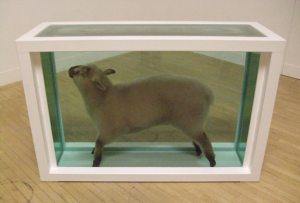
A study that found high levels of the carcinogen formaldehyde leaking from an exhibition by a prominent British artist may have unreliable data, according to its corresponding author.
The 2016 study about Damien Hirst’s exhibition at the Tate gallery in London in 2012 — which involved keeping dead animals in formaldehyde in glass cases — sparked concern in the mainstream media over the exhibition’s potential hazards to visitors.
But now the corresponding author of the paper — Pier Giorgio Righetti of the Polytechnic University of Milan in Italy — has alerted the journal, Analytical Methods, of the paper’s shortcomings. The journal has issued an expression of concern (EOC), and is investigating.
Here’s the EOC, issued this week:
The following article ‘Remote sensing of formaldehyde fumes in indoor environments’ by Gleb Zilberstein, Roman Zilberstein, Uriel Maor, Emmanuil Baskin, Shoumo Zhang and P. G. Righetti has been published in Analytical Methods. The article describes the fabrication of a miniaturized formaldehyde (FA) sensor to be worn as a wrist bracelet for monitoring the levels of FA in the environment.
The Royal Society of Chemistry has been contacted by the corresponding author to inform us that the data within the paper may not be reliable.
Analytical Methods is publishing this expression of concern to alert readers. An investigation is underway, and this notice will be updated when a final outcome is reached.
The study, published in April 2016, is yet to be indexed by Thomson Reuters Web of Science.
In the original paper, the authors report levels of formaldehyde exceeding legal limits:
…one of Hirst’s main subjects is the setting-up of giant fish tanks filled by thousands of liters of FA, in which intact biological specimens are immersed, such as zebras, cows, calves, even sharks. The parallelepiped-shaped basins are then covered with a lid and fully sealed with silicon gums. It has been found that the tanks are surrounded by FA fumes, constantly exuded in the atmosphere (likely via the sealant), reaching levels of 5 ppm, one order of magnitude higher than the 0.5 ppm limit set up by legislation.
At the time of publication of the study, Hirst’s company, Science Ltd, released a statement:
We do regular testing and our experts tell us that at the levels reported by this journal, your eyes would be streaming and you would be in serious physical discomfort. No such complaints were made to us during the show – or at any other shows or sites featuring the formaldehyde works. We don’t believe any risk was posed to the public.
Tate also issued a statement:
Tate always puts the safety of its staff and visitors first, and we take all the necessary precautions when installing and displaying our exhibitions. These works contained a very dilute formaldehyde solution that was contained within sealed tanks.
The Independent quotes this statement from the study’s authors:
The research from Dr. Zilberstein’s team and [Righetti] was intended to test the uses of a new sensor for measuring formaldehyde fumes and we do not believe that our findings suggest any risk to visitors at Tate Modern.
A spokesperson from the Royal Society of Chemistry, the journal’s publisher, told us:
An investigation, in collaboration with the authors, is now underway.
We’ve reached out to Hirst, Tate and Righetti, and will update the post with anything else we learn.
Update 7/15/16 2:39 p.m. eastern: We’ve learned that Righetti has requested to retract the paper.
Like Retraction Watch? Consider making a tax-deductible contribution to support our growth. You can also follow us on Twitter, like us on Facebook, add us to your RSS reader, sign up on our homepage for an email every time there’s a new post, or subscribe to our new daily digest. Click here to review our Comments Policy. For a sneak peek at what we’re working on, click here.
In my humble opinion the work of Hirst is toxic for completely different reasons, purely artistic and nothing to do with paraformaldehyde. To quote Mary Moore “you have to read the label to know what is going on”
The quote in The Independent is both old (it was issued by Tate on the scientists’ behalf in April) and disingenuous. No one has alleged any risk was pose to visitors. Prof Righetti only said that risks were pose to galkery staff.